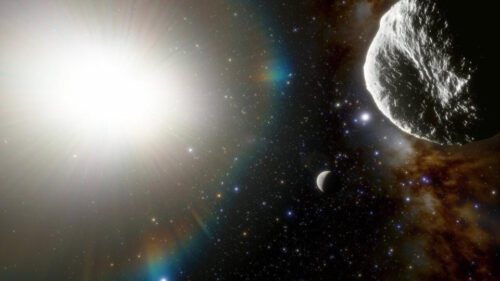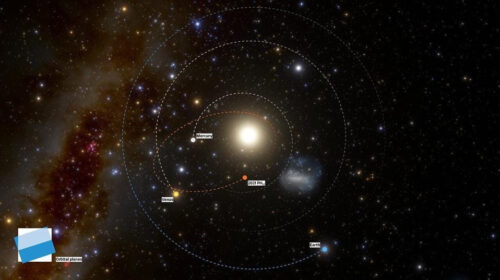
In a groundbreaking discovery, astronomers have detected the fastest-orbiting asteroid in the Solar System using the powerful 570-megapixel Dark Energy Camera (DECam) in Chile.
This asteroid, named 2021 PH27, boasts an elliptical and highly inclined orbit that brings it closer to the Sun than even Mercury.
With a closest approach of 20 million kilometers (12 million miles or 0.13 AU) every 113 days, it has surpassed the previous records for orbital speed.
Located at NOIRLab’s Cerro Tololo Inter-American Observatory (CTIO), the Victor M. Blanco 4-meter Telescope captured images of 2021 PH27, revealing its unique characteristics.
Despite having a longer orbital period than Mercury, this asteroid crosses the orbits of both Venus and Mercury.
With a diameter of approximately 1 kilometer, 2021 PH27 experiences extreme temperatures of nearly 900 degrees Fahrenheit (500 degrees Celsius) due to its proximity to the Sun, making it hot enough to melt lead.
The discovery of 2021 PH27 provides fascinating insights into the Sun’s new nearest neighbor, offering new possibilities for studying asteroids closer to Earth.

Understanding the population of asteroids within Earth’s orbit is crucial for completing the census of near-Earth asteroids, including those that could potentially collide with our planet. These asteroids, which may approach Earth during daylight and are difficult to detect in most nighttime surveys, present significant scientific interest.
The detection of 2021 PH27 was made possible through the combined efforts of astronomers Scott S. Sheppard from the Carnegie Institution of Science, Ian Dell’Antonio, and Shenming Fu from Brown University.
Utilizing the advanced capabilities of the 570-megapixel Dark Energy Camera (DECam), the team observed twilight images taken at the Victor M. Blanco 4-meter Telescope at CTIO.
While the origin of 2021 PH27 remains unknown, there are hypotheses surrounding its trajectory.
Sheppard suggests that the asteroid was likely ejected from the Main Asteroid Belt, located between Jupiter and Mars, influenced by the gravitational pull of the inner planets, ultimately leading to its current orbit.

However, due to its significant inclination angle of 32 degrees, it is also plausible that 2021 PH27 is an extinct comet from the outer Solar System that ventured closer to a planet as its path brought it inward.
Looking ahead, astronomers predict that 2021 PH27 will likely collide with either Mercury, Venus, or the Sun in the distant future, although such events are not expected to occur for millions of years.
This discovery opens new avenues for further research, enhancing our understanding of the Solar System’s dynamics and the intriguing objects that inhabit it.
As our exploration of the cosmos continues, advancements in telescope technology and the dedication of scientists unveil the mysteries of our celestial neighborhood.

The discovery of the fastest-orbiting asteroid using cutting-edge instruments like the Dark Energy Camera brings us closer to unraveling the secrets of our Solar System. Let your eyes gaze upon the night sky, for it holds wonders that continue to inspire and captivate us all.
